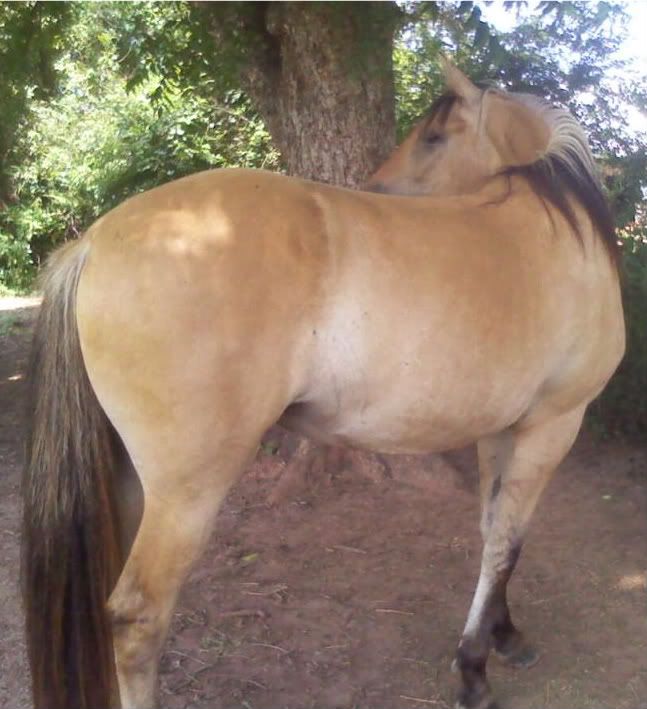|
|
Post by Michelle Clarke on May 6, 2010 18:55:59 GMT -5
The Front Legs
The front legs on a horse are meant to take stress, load and balance its own mass, plus add the saddle and within any movement you do. A front leg should have a square knee with the sides vertical for strength and durability - not rounded. Rounded joints tend to be draft and pony influence in the breeding.
The cannon bone must come off the knee symmetrically from the center. It makes sense that any deviation will cause undue stress on the upper and lower joints. Many times this is not genetically conformational but lack of proper nutrition to the mare before the foal is born. This is also a red flag to OCD's, as those are formed in the first year of a horses' life.
Looking at the profile of the front leg, the leg must be vertical without any deviation forward or back...especially back at the knee. Again, this is a basic weakness in the structure and functionability in the leg. As a general rule, Thoroughbreds actually have the perfect front leg (minus the feet) wit the shape of the joints, tendons and bones. The reason is that the selection for racing creates the ideal front leg as far as resistance to stress and loading.
The bone at the back of teh knee must clearly stick out backward, so the tendons have a lot of room to attach. The tendons must be clearly seperated as possible with the greatest distance between the front of the cannon bone and the back of the tendon. The legs must look "dry", with no soft tissue around the joint and the pastern must have a correct angle for weight bearing (around 60%). With all this said, the whole front leg can look off, especially the pastern angle, due to poor farrier work. For example, too much toe in the front can cause the horses leg to be behind the vertical.
The column of the leg must sit directly under the center of the shoulder (from point of shoulder to up near the wither) and over the foot in order that the foot can take the stress off the tendons and joints.
I'll get busy with finding pictures to go along with this...
|
|
|
|
Post by angelsdream on May 7, 2010 9:39:57 GMT -5
This is a great thread!! Thanks for everyone that is sharing there knowledge. I'm still learning so this is very enlightning...
Had a few questions, not sure if it pertains to saddle horse but more overall conformation issues. I know trimming is a big factor in growing horse's when it comes tendons, knees, etc and how they grow. If trimmed incorrectly or not trimmed at all, causes problems. I've seen horse's that were pigeon toed, one or both turned inward. Is the cause of this lack of trimming or trimming correctly and what other problems does this cause?
|
|
|
|
Post by Michelle Clarke on May 7, 2010 12:12:13 GMT -5
Yes, farrier work is very important during growth. I know breeders that don't put enough emphasis on it, mainly because while they have the horse during the young years, the don't have much problem. It's only later in life, after they have a job or get older that they begin to have residual issues.
Let me say something about the pigeon toe thing...alot of Spanish type horses toe out when they are young do to the slight chest and shoulder angles. Their elbows come in to support body mass, so the toe may turn out. When I first started this breeding program, my farrier would always "fix" that when they trimmed. However, I begin to notice when they matured, they permanentally turned in. After years of research I spoke to a vet in Spain and he said to leave them alone...no corrective work. Just trim them balanced as you hold the foot from the cannon bone (which a good farrier should do anyway). When you hold the leg from this position, the foot will hang naturally as it is. This is how you trim - not how you see it set on the ground. Since we have started this, we have not had any more issues as the horses get older.
I did run across an old farrier that used to work at a QH breeding farm that had a very famous stallion there...name escapes me at the moment. They had the same issues. When he just started doing balanced trims and quit trying to fix it, they all grew up normally. In fact, he was known as the only farrier that could keep that line of horses from toeing in.
Another thing that I do on each foot as they are trimmed, is to hold the pastern with one hand, then hold the bottom of the foot with the other. I turn that joint back and forth while pulling the hoof away from the leg. It opens up the joints and gives the farrier a better idea on balancing the foot. Those joints can get jammed for a variety of reasons. To prove what a difference it makes, I will let the farrier trim the foot, then I'll open the joints up and they can't belive that they have to go back and rebalance the foot.
|
|
|
|
Post by mystickiger on May 7, 2010 22:47:01 GMT -5
"Let me say something about the pigeon toe thing...alot of Spanish type horses toe out when they are young do to the slight chest and shoulder angles. Their elbows come in to support body mass, so the toe may turn out. When I first started this breeding program, my farrier would always "fix" that when they trimmed. However, I begin to notice when they matured, they permanentally turned in. After years of research I spoke to a vet in Spain and he said to leave them alone...no corrective work. Just trim them balanced as you hold the foot from the cannon bone (which a good farrier should do anyway). When you hold the leg from this position, the foot will hang naturally as it is. This is how you trim - not how you see it set on the ground. Since we have started this, we have not had any more issues as the horses get older.
Michelle, there has been alot of good discussion in this thread but this paragraph is the most important to me. Good farrier work is essential! Just trim them balanced as you hold the foot from the cannon bone; the foot will hang naturally is SO IMPORTANT. These horses are tough hoofed and on the surfaced balanced. But I have seen so many farriers cause clubbed feet, low slung heels, elevated heels and unsoundness by "eyeing" the foot. Done incorrectly this accentuates the problem. The same can be said for those that tout " they're mustangs with great feet so they don't need done. " Wrong!!!! A balanced horse on good ground with ample space will wear their hooves evenly. But even in that ideal situation it does not mean they will wear them sufficiently to require no trimming; then you add the rider into the mix! I've only owned 2 Kigers but know atleast 6 riding Kigers first hand. None of which can go without proper trimming atleast 4x yearly. Breeders and owners that say these horses wear evenly without good trimming obviously don't ride hard or often. I see so many pictures posted with horrible or more than likely NO hoof care. That is a major faux paux to the majority of the horseworld.
|
|
|
|
Post by sbutter on May 8, 2010 1:24:49 GMT -5
Just as a side note, is there a way to divide this up into a pro and con discussion? I know we are talking about just general saddle horse conformation and certain limitations, but it would be nice to understand the trade offs a little better. Such as a lot of muscling versus lesser muscling. More mass means more weight and can retain heat, but depending on whatever discipline you are in, you may need that extra muscle for the explosive power factor. Basically the trade offs for some of the common types of horses that you see from day to day. Of the three stallions that I posted, they were obviously bred for racing and did not have saddle conformation in mind, but they are still good to use for discussion. I agree of the three, I think the third would have the easiest time switching gears and be somewhat successful as a saddle horse. But with those TBs, you can see some of the trade offs. Stallion A = Street Boss was bred for more of the explosive sprinting races, so he carries the typical heavy muscling in the hind end. That would turn to a disadvantage if he had to run distance. All that extra weight to carry would slow him down and he would not have the staying power like the others. He was however very successful for his specified area of performance. So, I didn’t know if we wanted to cover this before we entered the Iberian realm. Also wasn’t sure if we wanted to talk about this in its little divisions as far as back, legs, etc…I am just thinking of the different variations of the “perfect” saddle horse for different disciplines. I don’t want to make it more complicated than it should be, but I want to make sure we cover some potential questions. lol..okay...carry on  |
|
|
|
Post by DianneC on May 8, 2010 8:32:24 GMT -5
I saw someone show up at Kigerfest with their horse's feet in horrible shape. So what did the spectator's think of that? I think there are some Kiger people that "do their own" horse's feet. Now, if you've really studied and gone to farrier school that's one thing. But I suspect they just do their best to save money and read some articles on the web. Worming and good farrier work are not optional for any captive horse.
I'd like to hear something about width of chest too.
|
|
|
|
Post by fantasykiger on May 8, 2010 13:38:20 GMT -5
Your welcome to use these photos and point out plus and minus's on these two horses. Cleo' - Kiger Mustang/Paint 16hnds..she is in foal in this photo so she is a bit round   Fantasy - Kiger Mustang/Warms Springs Mustang 15'2 hds 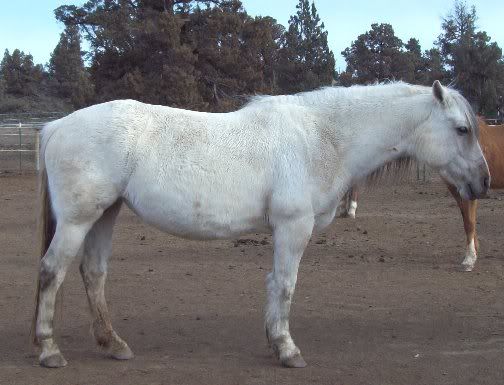 I know they are not perfect, even though they are wonderful  I do think Fantasy's back has changed over time, what once was a wide flat table top, now has much more prominant withers and tapered topline. |
|
|
|
Post by sbutter on May 10, 2010 17:19:55 GMT -5
Between the two, Cleo sticks out to me more as a western pleasure horse. The angle of Cleo's photo is taken more at her shoulder, so its a little hard to see what her legs look from the side. Fantasy has a perfect side shot. As far as disciplines go, I was thinking of comparing some of the top horses in each genre and then seeing what kind of similarities they have. I have noticed a lot of QHs seem to be built more downhill and I was curious if that gave them an advantage at all? Here are some pictures/ videos I found on the net. TR Dual Rey cutting horse 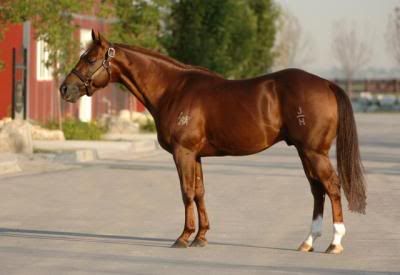  his page....http://www.sdpbuffaloranch.com/details.php?id=56 and video of him in action www.youtube.com/watch?v=TZdGPpl5jZ4Cor de la Bryère jumper 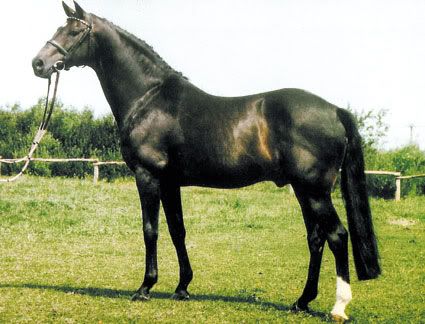  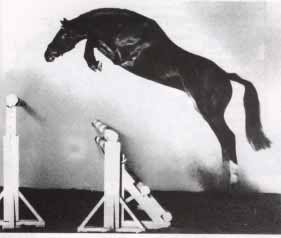 Info on him en.wikipedia.org/wiki/Cor_de_la_BryereRamiro showjumping  info on him www.horsemagazine.com/BREEDINGBARN/GREAT_STALLIONS/RAMIRO/ramiro.htmDonnerhall dressage 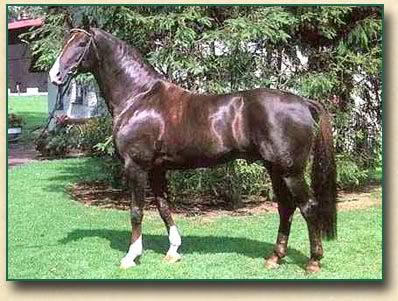 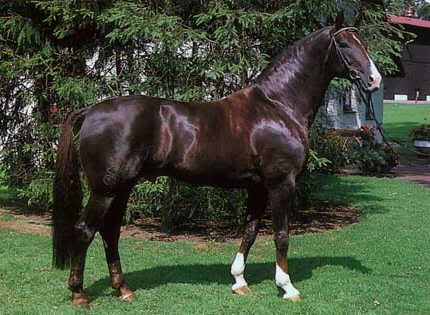 info www.sporthorse-breeder.com/ics/stallions/donnerhall.htmI can look around for more, but these were the easiest to find at the moment. |
|
|
|
Post by Michelle Clarke on May 10, 2010 20:00:05 GMT -5
These horses are definately built for their specialities...am I not so familiar with the ins and outs of specifics and why on speciality horses. I know that good cutting/reining horses are built uphill - downhill is a fault and though so people use them, it is not optimum. I watched a show with Al Dunning and that is what he was looking for, which surprised me. It is so much more than just conformation, they have to have the heart and desire, not to mention the right trainer and the right owner. So many horses never reach their potential, while on the other hand, some riders/trainers can get alot out of a horse that is not quite perfect, but it all seems to come together.
Many horses bred for special events do not make good saddle horses, simply because the breeding is so focused on that specific job.
|
|
|
|
Post by DianneC on May 10, 2010 21:59:27 GMT -5
Donnerhall is a wonderful stallion for dressage, I think Judy Yancey mentions him. I think his pictures are just reversed, I saw the brand and thought "who brands both sides of a horse?" then looked more closely. He would be great to use for several body parts.
|
|
|
|
Post by sbutter on May 12, 2010 1:34:39 GMT -5
Nothing gets by you Dianne  Well, at least one picture is a nice quality. I was looking hard for a good picture of him, but I never looked at the two side by side. You have a good eye for detail. That is a good point, these horses are great at what they were bred for, but would they really be a good saddle horse? They may not be very versatile, and I picture a saddle horse as a Jack of all trades. I just know people get certain visions of what they look for in a horse, so they have a certain bent towards disciplines. That is really interesting to hear that cutting/reining horses should be built more uphill. I had heard of that, so it makes me wonder why so many of them seem to be built down. I also wasn't sure if it was a result of their particular job. If they spent most of the time crouched down cutting a calf, how much of that would show in their build? Kind of like how certain jobs tend to leave certain features on people. So, somewhat of a nature/nurture thing. Still, it is interesting to note the common features with these horses and how the muscle is laid over the frame of the horse and how that applies to their jobs. It looks like this solidifies the good features in a saddle horse and that a good one should do fairly well in any discipline. |
|
|
|
Post by Michelle Clarke on May 12, 2010 6:42:50 GMT -5
Ideally, a cutting horse should be downhill so they can easily rock back on thier haunches and keep their weight there. Maybe because many of them are downhill that's why they break down so early in life...I don't know.
Donerhall was actually at a barn near us in Chicago. I've seen him just hangin' in his stall, nice looking horse. I like his topline, though if his legs were more underneath him, you'd see more dip in his back - but being that his head is too high also, it might level out some. He seems to be typically built in the rectangle for dressage and to have good extentions - not to mention his angles of shoulder and hip being more open for reaching too. I do like the position of his front leg under his shoulder mass - it comes out from the center line of the angle of the shoulder, coupled with fairly good angles on his feet which makes the line of the leg pretty much come over the heel of the foot for support. Personally, I'd move his heels back some for more support, but then he may loose some of the extention in gait. There are a lot of manipulations farriers can make to either make a horse leave the foot on the ground longer or pick it op quicker. A longer toe will cause the foot to be down for a longer period and a shorter toe with more heel will cause a horse more lift and a quicker stride. You'll see this in gaited horses and saddle seat types. However, with unnatural manipulation like that, ignoring what the foot really needs to be balanced, does eventually cause problems in the future of the horse.
Hopefully we are going to be getting some rain over the next five days so I'll have time to get some front leg pictures up...
|
|
|
|
Post by fantasykiger on May 12, 2010 11:15:18 GMT -5
At the recent Clinton Anderson Tour when he spoke of Mustangs he described them as the perfect saddle/trail horse because man has not bred them towards any one disipline. They are the true warm blood in that they can walk and remain calm but if called to react and run they can, then in a few moments go right back to grazing and relaxed. So they have the right disposition for a good saddle horse. This post is very helpful in choosing the right conformation on your mustang to get the full package.
|
|
|
|
Post by DianneC on May 12, 2010 16:56:01 GMT -5
I really like Donnerhalls's shoulder, I've been interested in the forearm angle and length since reading an article, who knows where. This is the bone from the elbow to the point of the chest where it connects with the shoulder blade. As I recall, the article said a longer bone with more angle enabled the horse to pick up its forelegs more easily with more reach, i.e. for jumping, but also I would think for all other activity too. Seems like they would be lighter on their feet. I'd be interested to hear more about it when we get to shoulders.
|
|
|
|
Post by sbutter on May 20, 2010 22:45:30 GMT -5
|
|



